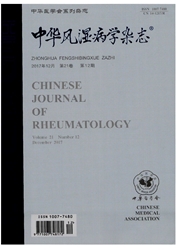

 中文摘要:
中文摘要:
目的 研究抗磷脂综合征(APS)的临床特点,分析不同时期的APS的分类标准,以提高对这一疾病的认识。方法 回顾性分析1996-2006年在仁济医院根据不同时期的分类标准诊断的APS患者的临床和实验室特点。结果 1996-2006年满足至少1个分类标准的患者共120例,其中符合1988年Asherson分类标准者有101例,符合1999年Sapporo标准者为96例。符合2006年Sydney标准者为115例。在115例APS患者中,男女比例为1:10.5,平均病程为82.6个月,平均年龄为(41±12)岁。其中90例患者发生血栓事件,以深静脉血栓、脑梗死、皮肤血管为主。92例已婚有生育史的女性患者中。有46例发生病态妊娠。7例患者发生恶性APS。抗心磷脂抗体阳性86例,抗β2-糖蛋白Ⅰ(β2-GP Ⅰ)抗体阳性58例,狼疮抗凝物阳性27例。结论 常见的血栓部位为下肢深静脉、脑梗死和皮肤血管。Sydney标准增加抗β2-GP Ⅰ抗体作为一项实验室指标,提高了分类标准的敏感性,但是对于一些仅有血小板减少和实验室指标阳性的原发性APS患者的诊断存在局限性。另外,一些针对凝血因子的抗体对APS诊断的意义有待深入研究。
 英文摘要:
英文摘要:
Objective To analyze three different classification criteria, the clinical characteristics of antiphospholipid syndrome (APS) in a cohort of Chinese patients. Methods From January 1996 to October 2006, APS patients diagnosed with different classification criteria were retrospectively studied. Results There were totally 120 APS patients fulfilled at least one criterion. One hundred and one patients fulfilled the 1988 Asherson criteria, 96 patients fulfilled the 1999 Sapporo criteria, and 115 patients fulfilled the 2006 Sydney criteria. The ratio of male to female in a cohort of 115 definite APS patients was 1 to 10.5. The mean period of the disease until entry into the study was 82.6 months, the mean age at study entry was (41±12) years. Ninety patients had thrombosis episodes, among which the most common presenting manifestations were deep venous thrombosis, stroke and skin vasculitis. Forty-six of 92 married women in our cohort had fetal morbidity. Catas- trophic APS occurred in 7 patients. The presence of anticardiolipin antibodies (aCL) was detected in 86 patients, anti-beta-2 glycoprotein Ⅰ antibodies in 58 patients and lupus anticoagulant (LA) in 27 patients. Conclusion The most common presenting manifestations are deep venous thrombosis, stroke and cutaneous manifestations. The sensitivity of Sydney classification criteria is improved by adding anti-beta-2 glycoprotein Ⅰantibody as one of the laboratory criteria. However, primary APS patients who only presented with thrombocytopenia and positive laboratory tests could not satisfy this criterion. In addition, the significance of autoantibodies to some coagulant factors in APS needs further study.
 同期刊论文项目
同期刊论文项目
 同项目期刊论文
同项目期刊论文
 期刊信息
期刊信息
